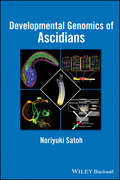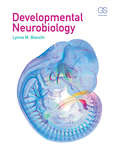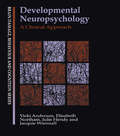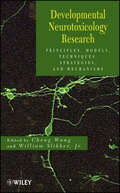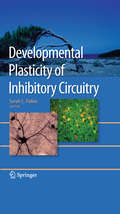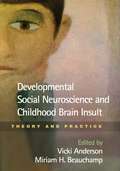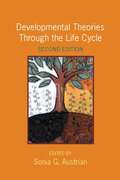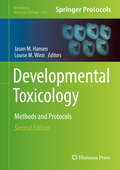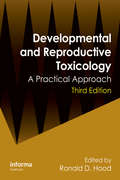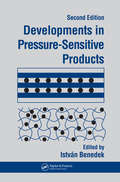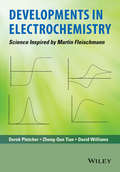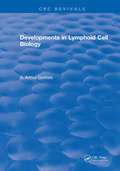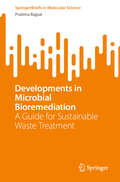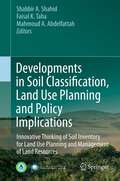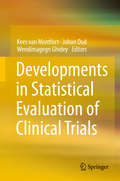- Table View
- List View
Developmental Genomics of Ascidians
by Noriyuki SatohThe simplicity and lack of redundancy in their regulatory genes have made ascidians one of the most useful species in studying developmental genomics. In Developmental Genomics of Ascidians, Dr. Noriyuki Satoh explains the developmental genomics of ascidians, stresses the simplicity of Ciona developmental system, and emphasizes single-cell level analyses. This book actively accentuates the advantages of using ascidians as model organisms in an up-and-coming field of developmental genomics.
Developmental Neurobiology
by Lynne BianchiDevelopmental Neurobiology tells the extraordinary process of neural development by showing how the scientific discoveries were made and how the hypotheses evolved over time. Each chapter explores the specific mechanisms of development while highlighting the key experiments and methods used to make those discoveries—including descriptions of, and experiments utilizing, both invertebrate and vertebrate animal models. This distinctive approach provides the essential facts while strengthening the reader’s appreciation of the scientific method. Discussions of neurodevelopmental disorders and therapeutic approaches to them will captivate those interested in the more clinical aspects of the field. With its clear illustrations and easy-to-follow writing style, Developmental Neurobiology presents an accessible approach to neural development for undergraduate students.
Developmental Neuropsychology: A Clinical Approach
by Vicki Anderson Elisabeth Northam Jacquie WrennallThis book addresses key issues in child neuropsychology but differs from other books in the field in its emphasis on clinical practice rather than research issues. Although research findings are presented, they are described with emphasis on what is relevant for assessment, treatment and management of pediatric conditions. The authors have chosen to focus on a number of areas. First, the text examines the natural history of childhood CNS insult, highlighting studies where children have been followed over time to determine the impact of injury on ongoing development. Second, processes of normal and abnormal cerebral and cognitive development are outlined and the concepts of brain plasticity and the impact of early CNS insult discussed. Finally, using a number of common childhood CNS disorders as examples, the authors develop a model which describes the complex interaction among biological, psychosocial and cognitive factors in the brain injured child.The text will be of use on advanced undergraduate courses in developmental neuropsychology, postgraduate clinical training programmes, and for professionals working with children in clinical psychology, clinical neuropsychology, and in educational and rehabilitation contexts.
Developmental Neuropsychology: A Clinical Approach (Brain, Behaviour and Cognition)
by Vicki Anderson Elisabeth Northam Jacquie WrennallThis fully updated edition of Developmental Neuropsychology: A Clinical Approach addresses key issues in child neuropsychology with a unique emphasis on evidence-informed clinical practice rather than research issues. Although research findings are presented, they are described with emphasis on what is relevant for assessment, treatment and management of paediatric conditions. The authors focus on a number of areas. First, the text examines the natural history of childhood central nervous system (CNS) insult, highlighting studies where children have been followed over time to determine the impact of injury on ongoing development. Second, processes of normal and abnormal cerebral and cognitive development are outlined and the concepts of brain plasticity and the impact of early CNS insult discussed. Third, using a number of common childhood CNS disorders as examples, the authors develop a model which describes the complex interaction among biological, psychosocial and cognitive factors in the brain-injured child. Finally, principles of evidence-based assessment, diagnosis and intervention are discussed. The text will be of use on advanced undergraduate courses in developmental neuropsychology, postgraduate clinical training programmes and for professionals working with children in clinical psychology, clinical neuropsychology and educational and rehabilitation contexts. The text is also an important reference for those working in paediatric research.
Developmental Neurotoxicology Research: Principles, Models, Techniques, Strategies, and Mechanisms
by Jr. Cheng Wang William SlikkerThis book describes how systems biology, pharmacogenomic and behavioral approaches, as applied to neurodevelopmental toxicology, provide a structure to arrange information in a biological model. Authors review and discuss approaches that can be used as effective tools to dissect mechanisms underlying pharmacological and toxicological phenomena associated with the exposure to drugs or environmental toxicants during development. This book presents cross-cutting research tools and animal models, along with applications to the studies associated with potential anesthetic-induced developmental neurotoxicity; the developmental basis of adolescent or adult onset of disease; risk assessment of methyl mercury and its effects on neurodevelopment; challenges in the field to identify environmental factors of relevance to autism; and the strategy and progress of epilepsy research.
Developmental Origins of Health and Disease: From Biological Basis to Clinical Significance (Advances in Experimental Medicine and Biology #1012)
by Takeo Kubota Hideoki FukuokaThis book addresses the developmental origins of health and disease (DOHaD), a new medical concept that demonstrates that various adult diseases start in the fetal period. It discusses our current understanding of the molecular mechanisms of DOHaD, including gene body epigenetics and non-coding RNA, and comprehensively examines diseases such type 2 diabetes, a well known as standard DOHaD-associated disease, as well as non-alcoholic fatty liver disease, hypertension and neurodevelopmental disorders. It argues that most adult diseases start at a very early stage, such as in the fetal and neonatal periods, and that earlier prevention and intervention would result in better outcomes for adult diseases such as type 2 diabetes and cardiac disorders, which are increasing in both developed and developing countries. The book appeals to obstetricians and pediatricians, as well as physicians who treat adult patients, wanting to understand the origins of diseases.
Developmental Plasticity of Inhibitory Circuitry
by Sarah L. PallasNeuroscience has long been focused on understanding neural plasticity in both development and adulthood. Experimental work in this area has focused almost entirely on plasticity at excitatory synapses. A growing body of evidence suggests that plasticity at inhibitory GABAergic and glycinergic synapses is of critical importance during both development and aging. The book brings together the work of researchers investigating inhibitory plasticity at many levels of analysis and in several different preparations. This topic is of wide relevance across a number of different areas of research in neuroscience and neurology. Medical problems such as epilepsy, mental illness, drug abuse, and movement disorders can result from malfunctioning inhibitory circuits. Further, the maturation of inhibitory circuits may trigger the onset of critical periods of neural circuit plasticity, raising the possibility that such plastici periods could be reactivated for medical benefit by manipulating inhibitory circuitry.
Developmental Social Neuroscience and Childhood Brain Insult
by Vicki Anderson Miriam H. BeauchampSynthesizing cutting-edge knowledge from multiple disciplines, this book explores the impact of acquired brain injury and developmental disabilities on children's emerging social skills. The editors present an innovative framework for understanding how brain processes interact with social development in both typically developing children and clinical populations. Key issues in assessment are addressed, including ways to measure both social function and brain function using developmentally sound tools. Balancing theoretical and clinical concerns, the book describes promising interventions for promoting children's adjustment and helping them participate more fully in the social world. Illustrations include six color plates.
Developmental Theories Through the Life Cycle (2nd Edition)
by Sonia G. AustrianThe life cycle, until recently, has been neither descriptive nor conceptual but metaphorical, suggesting an underlying sequence of events that everyone experiences rather than clear external milestones of development, althought every life, of course, is acknowledged to be unique.
Developmental Toxicology (Target Organ Toxicology Series)
by Deborah K. Hansen Barbara D. AbbottHighlighting latest advances in genetics and biochemistry, the completely revised Third Edition reviews the field from basic science, clinical, epidemiological, and regulatory perspectives. Contributions from top opinion leaders in the field bring together developments in molecular embryology and cell biology as they apply to problems in developmen
Developmental Toxicology: Methods and Protocols (Methods in Molecular Biology #1965)
by Jason M. Hansen Louise M. WinnThis thorough edition explores numerous methodological approaches that can be extremely informative for our understanding of the developmental toxicant mechanisms, characterization of developmental outcomes, and development of potential interventions that are clinically relevant. Presenting both staple and state-of-the-art approaches, the book focuses on numerous cellular models (induced pluripotent stem cells, neural crest culture, etc.), some less frequently used but important animal models (chick, zebrafish), in vitro approaches using whole embryos (rat, mouse and rabbit), and specific outcome methodologies to assess changes on the morphological to molecular level. Written for the highly successful Methods in Molecular Biology series, chapters include the kind of detail and expert implementation advice that allows for smooth processes in the lab. Authoritative and practical, Developmental Toxicology: Methods and Protocols, Second Edition serves as an ideal aid to support further investigation into the specific mechanisms and outcomes of developmental exposures.
Developmental and Reproductive Toxicology: A Practical Approach
by Ronald D. HoodCompletely revised and updated, Developmental and Reproductive Toxicology: A Practical Approach, Second Edition draws together valuable information typically scattered throughout the literature, plus some not previously published, into one complete resource. In addition to the traditional aspects of developmental toxicity testing, the book covers e
Developments In Pressure-Sensitive Products
by István BenedekSince the first groundbreaking edition of Developments in Pressure-Sensitive Products was introduced in 1998, heavy research has resulted in substantial progress in the field. Fully updated and expanded to reflect this activity, Developments in Pressure-Sensitive Products, Second Edition provides a detailed overview of the entire range of pressure-
Developments in Bioethanol (Green Energy and Technology)
by Pratima BajpaiThis book provides an updated and detailed overview on the recent developments of bioethanol technology. It looks at the historical perspectives, chemistry, sources and production of ethanol and discusses biotechnology breakthroughs and promising developments, its uses, advantages, problems, environmental effects and characteristics. In addition, it presents information about ethanol in different parts of the world and also highlights the challenges and future of ethanol. The first edition of this book was published as a SpringerBriefs in 2013. Since then, many new developments have taken place in the last six years. This new edition will highlight the evolution in bioethanol development from first-generation production to the futuristic fourth-generation bioethanol production, the various constraints and challenges involved, and the scope for development. This book caters to the audience who are interested in alternative transportation fuels which are both biodegradable and sustainable to the environment.
Developments in Corporate Governance: Emerging Market Perspective (Approaches to Global Sustainability, Markets, and Governance)
by Arun Kumar Tripathy Vinay Kandpal Nidhi S. BishtThis book explores the dynamic landscape of corporate governance, focusing on the perspective of emerging markets. It delves into the evolving governance frameworks of these markets, highlighting variations in board structures, CEO roles, and director compositions due to diverse traditions and cultures. Emerging markets differ significantly from developed markets, characterized by concentrated ownership and the prevalence of family business groups within weak property rights environments. Additionally, there is a notable tension between direct ownership and control rights in these markets. The book's relevance is underscored by the growing importance of emerging markets in the global economy. These markets have contributed significantly to global output and growth, rapidly integrating into global trade and finance networks. Advocating for a dynamic view of corporate governance, the book emphasizes the need for continuous evaluation and adaptation of governance practices. It covers contemporary governance topics such as the role of whistle-blowers, governance challenges in start-ups, governance practices in family firms, and evolving governance regulations in emerging economies. This diverse coverage deepens readers' understanding of developments in governance issues, particularly within emerging economies.
Developments in Electrochemistry
by David Williams Zhong-Qun Tian Derek PletcherMartin Fleischmann was truly one of the 'fathers' of modern electrochemistry having made major contributions to diverse topics within electrochemical science and technology. These include the theory and practice of voltammetry and in situ spectroscopic techniques, instrumentation, electrochemical phase formation, corrosion, electrochemical engineering, electrosynthesis and cold fusion. While intended to honour the memory of Martin Fleischmann, Developments in Electrochemistry is neither a biography nor a history of his contributions. Rather, the book is a series of critical reviews of topics in electrochemical science associated with Martin Fleischmann but remaining important today. The authors are all scientists with outstanding international reputations who have made their own contribution to their topic; most have also worked with Martin Fleischmann and benefitted from his guidance.Each of the 19 chapters within this volume begin with an outline of Martin Fleischmann's contribution to the topic, followed by examples of research, established applications and prospects for future developments.The book is of interest to both students and experienced workers in universities and industry who are active in developing electrochemical science.
Developments in Fungal Biology and Applied Mycology
by Tulasi Satyanarayana Sunil K. Deshmukh B. N. JohriThis book explores the developments in important aspects of fungi related to the environment, industrial mycology, microbiology, biotechnology, and agriculture. It discusses at length both basic and applied aspects of fungi and provides up-to-date laboratory-based data. Of the estimated three million species of fungi on Earth, according to Hawksworth and coworkers, more than 100,000 have been described to date. Many fungi produce toxins, organic acids, antibiotics and other secondary metabolites, and are sources of useful biocatalysts such as cellulases, xylanases, proteases and pectinases, to mention a few. They can also cause diseases in animals as well as plants and many are able to break down complex organic molecules such as lignin and pollutants like xenobiotics, petroleum and polycyclic aromatic compounds. Current research on mushrooms focuses on their hypoglycemic, anti-cancer, anti-pathogenic and immunity-enhancing activities. This ready-reference resource on various aspects of fungi is intended for graduate and post-graduate students as well as researchers in life sciences, microbiology, botany, environmental sciences and biotechnology.
Developments in Handwriting and Signature Identification in the Digital Age
by Heidi H. HarralsonThe examination of handwriting and signatures has a long and established history as a forensic discipline. With the advancement of technology in the use of digital tablets for signature capture, changes in handwriting examination are necessary. Other changes in handwriting, such as in increase in printed writing styles and the decrease in handwriting training in schools necessitates a re-examination of forensic handwriting identification problems. This text takes a fresh and modern look at handwriting examination as it pertains to forensic, legal, and criminal justice applications.
Developments in Lymphoid Cell Biology
by A. Arthur GottliebIn this volume the author by no means attempted to give a comprehensive view of the myriad of recent developments in immunology. The author has attempted, after introducing sufficient background in chapter 1, to highlight certain areas of lymphoid cell biology which are given less attention in current thinking but which seem to the author to offer exciting prospects for research. In other cases, the important topics of transplantation and tolerance are looked at from points of view which are somewhat less conventional in the hope that these aspects may stimulate others to look at the yet unsolved problems in these areas. In making the selection of topics and indeed in the selection of references within each chapter, the contributors and the author have attempted to select those which offered what seemed to be the best sources of information. They do not wish to minimize the important contributions of others but are guided by constraints of brevity and cogent expression.
Developments in Mathematical and Conceptual Physics: Concepts and Applications for Engineers
by Harish ParthasarathyThis book presents concepts of theoretical physics with engineering applications. The topics are of an intense mathematical nature involving tools like probability and random processes, ordinary and partial differential equations, linear algebra and infinite-dimensional operator theory, perturbation theory, stochastic differential equations, and Riemannian geometry. These mathematical tools have been applied to study problems in mechanics, fluid dynamics, quantum mechanics and quantum field theory, nonlinear dynamical systems, general relativity, cosmology, and electrodynamics. A particularly interesting topic of research interest developed in this book is the design of quantum unitary gates of large size using the Feynman diagrammatic approach to quantum field theory. Through this book, the reader will be able to observe how basic physics can revolutionize technology and also how diverse branches of mathematical physics like large deviation theory, quantum field theory, general relativity, and electrodynamics have many common issues that provide the starting point for unifying the whole of physics, namely in the formulation of Grand Unified Theories (GUTS).
Developments in Microbial Bioremediation: A Guide for Sustainable Waste Treatment (SpringerBriefs in Molecular Science)
by Pratima BajpaiThis book sheds new light on the transformative role of microorganisms in waste management, offering a comprehensive overview of microbial waste management strategies and their applications. Through this book, readers will learn about the latest advancements in bioremediation and microbial consortia technology, providing a fresh perspective on sustainable waste treatment solutions. The chapters cover topics such as the types and origins of waste, the importance of microorganisms in various waste management processes, and the benefits of bioremediation compared to traditional methods. Readers will discover diverse strategies for managing microbial waste, including bioleaching, bioaugmentation, and utilizing microorganisms to aid phytoremediation. The book also discusses the combined use of bacteria and microalgae for wastewater treatment and emerging innovations in microbial consortia technology. Critical attention is given to the role of microbes in multiple industrial applications such as pharmaceuticals, food processing, textiles, explosives, distilleries, and petrochemicals. Additionally, it explores bioinformatics approaches like genomics and proteomics that drive bioremediation efforts. This volume is an essential resource for researchers in environmental science, biotechnology professionals focusing on sustainable practices, scholars studying advanced wastewater treatment methods using nanotechnology or plant species integration with microorganisms. It invites readers to think through critical questions about sustainable waste treatment practices while offering valuable insights into future perspectives on microbial waste management.
Developments in Soil Classification, Land Use Planning and Policy Implications
by Shabbir A. Shahid Mahmoud A. Abdelfattah Faisal K. TahaAs the world's population continues to expand, maintaining and indeed increasing agricultural productivity is more important than ever, though it is also more difficult than ever in the face of changing weather patterns that in some cases are leading to aridity and desertification. The absence of scientific soil inventories, especially in arid areas, leads to mistaken decisions about soil use that, in the end, reduce a region's capacity to feed its population, or to guarantee a clean water supply. Greater efficiency in soil use is possible when these resources are properly classified using international standards. Focusing on arid regions, this volume details soil classification from many countries. It is only once this information is properly assimilated by policymakers it becomes a foundation for informed decisions in land use planning for rational and sustainable uses.
Developments in Soil Salinity Assessment and Reclamation
by Shabbir A. Shahid Mahmoud A. Abdelfattah Faisal K. TahaThe papers assembled here cover topics such as technological advances in soil salinity mapping and monitoring, management and reclamation of salt-affected soils, use of marginal quality water for crop production, salt-tolerance mechanisms in plants, biosaline agriculture and agroforestry, microbiological interventions for marginal soils, opportunities and challenges in using marginal waters, and soil and water management in irrigated agriculture.
Developments in Statistical Evaluation of Clinical Trials
by Kees Van Montfort Johan Oud Wendimagegn GhideyThis book describes various ways of approaching and interpreting the data produced by clinical trial studies, with a special emphasis on the essential role that biostatistics plays in clinical trials. Over the past few decades the role of statistics in the evaluation and interpretation of clinical data has become of paramount importance. As a result the standards of clinical study design, conduct and interpretation have undergone substantial improvement. The book includes 18 carefully reviewed chapters on recent developments in clinical trials and their statistical evaluation, with each chapter providing one or more examples involving typical data sets, enabling readers to apply the proposed procedures. The chapters employ a uniform style to enhance comparability between the approaches.
Developments in the Flow of Complex Fluids in Tubes
by Dennis A. SiginerThis book is dedicated to the tube flow of viscoelastic fluids and Newtonian single and multi-phase particle-laden fluids. This succinct volume collects the most recent analytical developments and experimental findings, in particular in predicting the secondary field, highlighting the historical developments which led to the progress made. This book brings a fresh and unique perspective and covers and interprets efforts to model laminar flow of viscoelastic fluids in tubes and laminar and turbulent flow of single and multi-phase particle-laden flow of linear fluids in the light of the latest findings.
